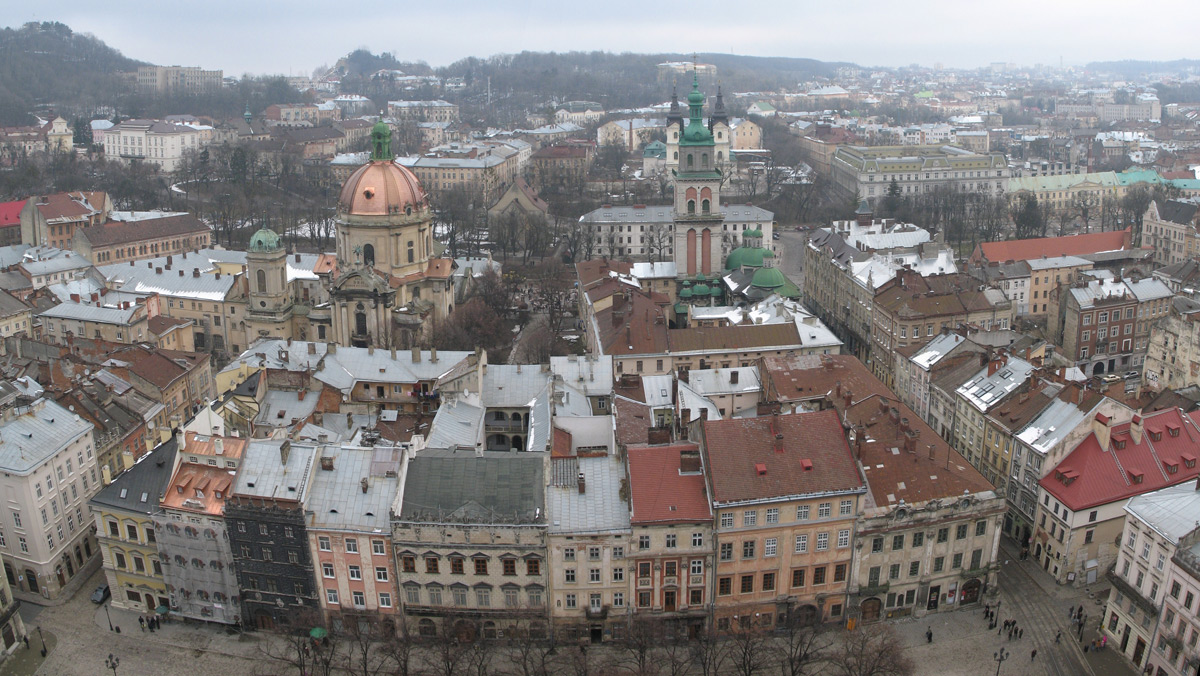EURO-2012 - Ukraine and Lviv welcomes you, bro
 •
by
•
by imamradyk

Portuguese fans love LVIV

The city of Lviv is crossed by one of the longest integer land meridians 24° of East longitude in the Eastern Hemisphere (East of Greenwich). According to calculations conducted in April-May 2012 by Dr. Hirnyj, this meridian crosses 3235 km of European, 7346 km of African and 2235 km of Antarctic ice-covered land including islands, which sums up to 12816 km. This is only 341 km shorter than the extent of land crossed by the meridian 22° of East longitude.

Lviv is located on the edge of the Roztochia Upland, approximately 70 km from the Polish border and 160 km (99 mi) from the eastern Carpathian Mountains. The average altitude of Lviv is 296 m (971.13 ft) above sea level. Its highest point is the Vysokyi Zamok (High Castle), 409 m (1,341.86 ft) above sea level. This castle has a commanding view of the historic city centre with its distinctive green-domed churches and intricate architecture.

The old walled city was at the foothills of the High Castle on the banks of the river Poltva. In the 13th century, the river was used to transport goods. In the early 20th century, the Poltva was covered over in areas where it flows through the city; the river flows directly beneath the central street of Lviv, Freedom Avenue (Prospect Svobody) and the renowned Lviv Opera House.










STADION


Lviv's historic churches, buildings and relics date from the 13th century. In recent centuries it was spared some of the invasions and wars that destroyed other Ukrainian cities. Its architecture reflects various European styles and periods. After the fires of 1527 and 1556 Lviv lost most of its gothic-style buildings but it retains many buildings in renaissance, baroque and the classic styles. There are works by artists of the Vienna Secession, Art Nouveau and Art Deco.

The buildings have many stone sculptures and carvings, particularly on large doors,which are hundreds of years old. The remains of old churches dot the central cityscape. Some three- to five-storey buildings have hidden inner courtyards and grottoes in various states of repair. Some cemeteries are of interest: for example the Lychakivskiy Cemetery where the Polish elite were buried for centuries. Leaving the central area the architectural style changes radically as Soviet-era high-rise blocks dominate. In the centre of the city the Soviet era is reflected mainly in a few modern-style national monuments and sculptures.






Welcome

German and Portuguese fans: We are "shocked" by your city!
German fans in Lviv before match


Comments
[removed]
понаїхали
v
Ні, от що не кажіть, а непевне за Львів єдиний мені не соромно
Львів ок
І все-таки це свято на нашій вулиці)
Львів на фотках ок. Може колись він весь буде таким, як центр.
v
вітаю, хлопаки!
файної забави!!!
о7
[removed]
мегавот
подобаються мені ці німці напроти ратуші))))
no FEMEN no VOTE !!
hochu shto bi dobavili femene fotk o7
[removed]
Mamont
москалям ніколи у львові ми не раді
це для когось новина?
[removed]
V
яке феменофільське падло зарепортило?
Voted!
vizavi яке феменофільське падло зарепортило?
Хто зарепортив не знаю, але я теж люблю жінок.
мамонт школьник 16 лет, что он понимает))
фемен то не зовсім жінки
а що?
бидло-баби, тупі і безгруді
Slava Ukraini
ну что ж , значит неадекваты. или скажешь нет?
vizavi бидло-баби, тупі і безгруді
При таких чоловіках, яких ти ще хотів?
ні, фемен - виключення, далеке від українських жінок
уроди. не сраміть Неньку. дискутуйте про свої сексуальні вподобання в іншому місці. я статтю в топ гнатиму
Гарне місто !
Звісно ж,- ВОТЕД))
Mamont
москалям ніколи у львові ми не раді
це для когось новина? х2
Мамонт, а за сайтик дякую. Я там навіть статтю знайшов «Украинская БЫДЛОМОВА - доктрина врагов Святой Руси», а під нею малюнок. І от тепер думаю, ти корова чи свиня?
А щодо «бійки», то її не було. Міліцію змусили прийти і забрати неадекватних москалів, які у Львові кричали щось про те, що вони ненавидять всіх, хто не москаль. Т.зв. «бійку» ініціював колега, який пред’явив міліції посвідчення держслужбовця, щоб ті зарухались.
звісно ні,неадекватність тут нідочого
кацапня у львові ніколи не буде кричати
"рассія рассія" і т.д.
а в вас там в підмосковій хай що хочуть то роблять
чого ж москалів слабо побили?
Меліовант правильно сказав..бійки фактично не було
все тільки йшло до бійки...один чувак накинувся на москаля
поки вже інші добігли їх розборонили
от і все...
а жаль..так жаль що не навалили їм по пискам
ну нічого..в польщі ще отримають
Beautiful! I want live with Kromov in Lviv 😛 !
Carta abierta a los admins.
Letter for admins.
ESP*ENG
✪ http://www.erepublik.com/es/article/2055537/1/20 ✪
Блин, вы можете ХОТЯ БЫ ВО ВРЕМЯ ЕВРО не сраться на национальные темы? Тьфу.
а Львов крутой, други оттуда рапортуют, очень довольны.
ну місто в нас гарне,може і рапортують,але бачили б ви наскільки ми готові..не зовсім так,як мало би бути..)
V
россія - №1 http://www.youtube.com/watch?v=Qw72aX_QlnI&feature=youtu.be
imamradyk уроди. не сраміть Неньку.
Де там? Тебе вже не переплюнути.
да когда же вы поймете - нужно быть адекватными и толерантными
пффф,
что с вас взять? только и умеете кричать: "Смерть маскалям! Слава Украине!" и бла бла.
короче я оффаюсь.
Всем добра
красивый город. На хорошо не скажешь плохо.
москалененависники своїми коментарями ви показуєте, що не далеко то втікли від тих, кого ненавидите. такі ж вузьколобі😕
Але це все стосується РЛ.
А в ерепі - більше ненависті, треба більше ненависті!😃😃
Дуже вотед
понравилось)
особенно пикча, где ночью сфотографирован храм подсвеченный...
вообще мне нравятся храмы Украинские, если не ошибаюсь Украинское барокко, или что-то в этом стиле, они очень богато украшены внешне... Был в Киеве, вообще зачётные
Voted
да когда же вы поймете - нужно быть адекватными и толерантными
Адекватними - так. Толерантними - НІКОЛИ!
I love this city! the most beautiful in Ukraine! ♥♥♥♥♥♥♥♥♥♥♥♥
Імаме, чудова робота! тільки треба було її перед початком Євро 2012 зробити! а все одно
Дуже вотедх2